...and a 2500-rpm stall speed converter would be even quicker, since
the engine could be held against the brake, preloading the converter,
to build usable boost pressure before leaving the starting line.
Other possibilities include running with open exhaust, bypassing the
catalytic converter and mufflers for |
|
off-road use and substituting
premium fuel. In this mode of operation, the system will produce 9-11
pounds of boost. And if that isn't enough, H-O also has a twin
turbo kit that will similarly fit under the stock hood [never produced].
Other options, such as a waste gate and a compressor mounted water
injection system are also available for all-out |
|
applications. Additionally
for the do-it-yourselfer, the pressure bonnet and Q-Jet modification
pieces, the waste gate, the water injection system, the Rajay turbos,
and most other kit components can be purchased separately, thus simplifying
"blow thru" installations on any vehicle.
Study the accompanying photos and application list. You may find just
what you need to "transform" your machine into a force-fed muscle car.
|

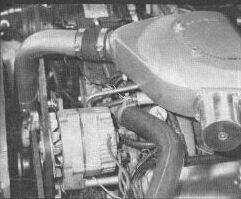 All lines have been routed to clear all existing belts and
accessories, including air conditioning.
All lines have been routed to clear all existing belts and
accessories, including air conditioning.
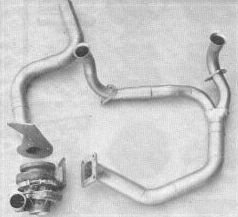 The heart of the system is the exhaust plumbing and
the compact Rajay 301E turbocharger. Note the small hole
atop the compressor inlet for attachment of the optional
water injection.
The heart of the system is the exhaust plumbing and
the compact Rajay 301E turbocharger. Note the small hole
atop the compressor inlet for attachment of the optional
water injection.
 Greatly simplifying the installation, is this modified
front engine cover. It includes the turbo oil drain provision
and a relocated lower radiator hose outlet. Also included is a
special lower radiator hose and the turbo oil supply and
return lines.
Greatly simplifying the installation, is this modified
front engine cover. It includes the turbo oil drain provision
and a relocated lower radiator hose outlet. Also included is a
special lower radiator hose and the turbo oil supply and
return lines.
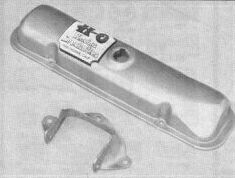 To provide clearance for the turbo exhaust, the
right side of the engine is raised slightly with a special
motor mount. Raising the engine creates an access problem
with the left valve cover, so a modified valve cover
is provided to clear the power brake.
To provide clearance for the turbo exhaust, the
right side of the engine is raised slightly with a special
motor mount. Raising the engine creates an access problem
with the left valve cover, so a modified valve cover
is provided to clear the power brake.
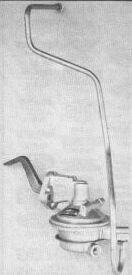 On "blow through" installations, fuel pressure must be
higher that boost pressure. This modified fuel pump is
connected via a pressure line to the carb float bowl to
reference pump pressure above boost pressure. The preformed
steel fuel line is also supplied.
On "blow through" installations, fuel pressure must be
higher that boost pressure. This modified fuel pump is
connected via a pressure line to the carb float bowl to
reference pump pressure above boost pressure. The preformed
steel fuel line is also supplied.
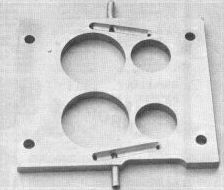 This plate is installed beneath the carb to
pressurize the modified throttle shaft bosses with dry air,
thus preventing a possible leak of fuel-contaminated air into
the engine compartment.
This plate is installed beneath the carb to
pressurize the modified throttle shaft bosses with dry air,
thus preventing a possible leak of fuel-contaminated air into
the engine compartment.